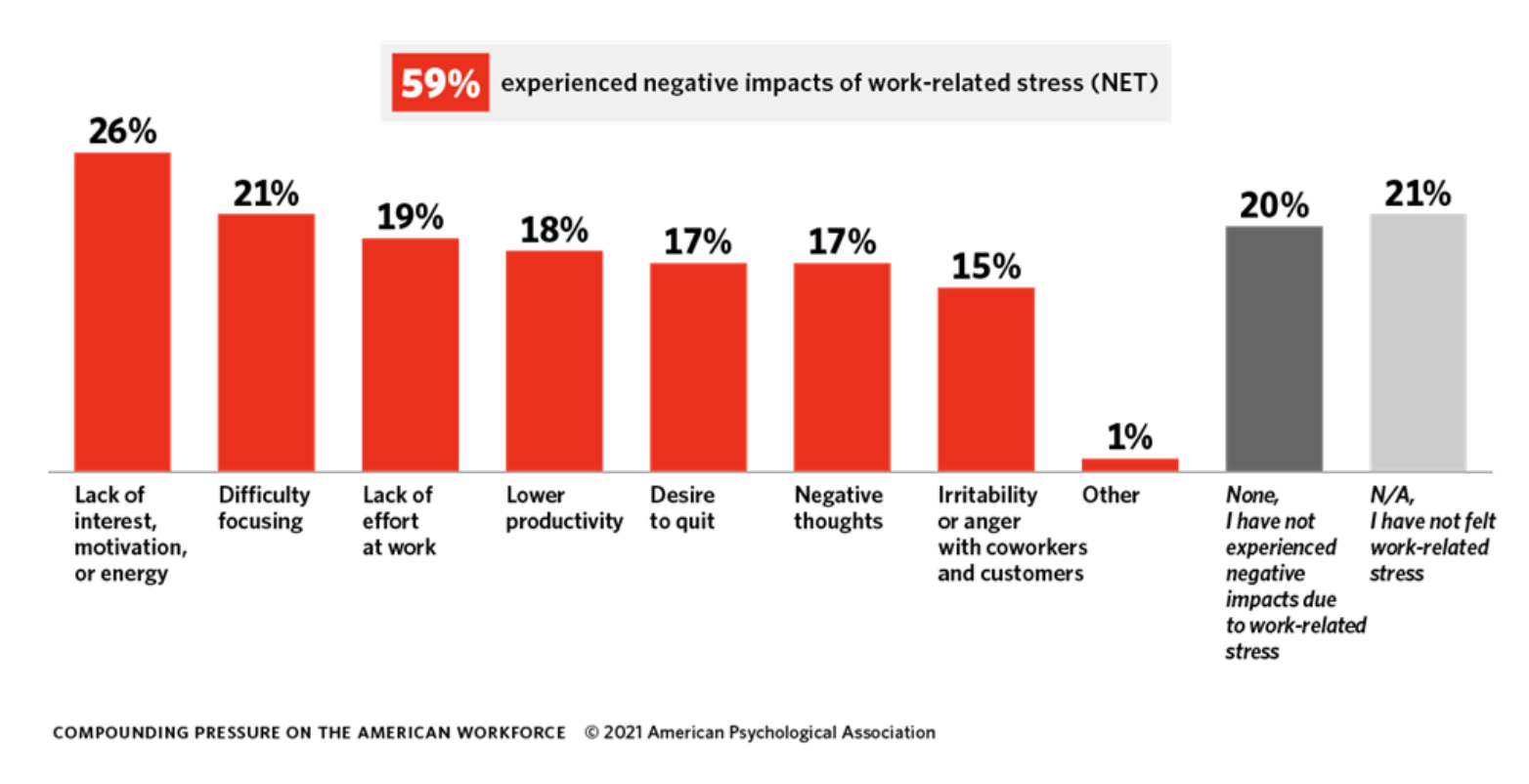January is Mental Wellness Month and nearly two years since the WHO declared COVID-19 a global pandemic. Many of us are tired and feel like we’ve lost steam or general engagement in our work.
At Partnership Leaders, we’re committed to supporting professionals not just in their careers but also in their personal lives. Today, we’re honored to be joined by Jessalyn Klein, Ph.D., a licensed psychologist in part-time private psychotherapy practice and part-time consulting for organizations like Workato that prioritize keeping their people and culture well in the midst of rapid growth. Jessalyn shared information about mental wellness, including how to recognize when it’s faded and start feeling like yourself again.
My gut sense was that clients and employees were reporting more work-related stress over the course of the pandemic, but the American Psychological Association (APA) 2021 Work and Well-Being Survey validated this wasn’t just my perception. Nearly 80% of employees noted work-related stress the month they took the survey and about 60% of employees noticed this stress was negatively impacting them. Check out the negative impacts reported in the APA’s graph below and consider whether any of these resonate for you.

Burnout can affect anyone. Interestingly, the negative impacts of work-related stress are more commonly reported amongst lower-level workers; however, the experience of stress and burnout is particularly complex for those in management roles. Leaders often have a real awareness of how their mood impacts their team. Many feel obligated to hold things together for those around them. And while the pandemic resulted in downturns in some industries, tech has seen a huge uptick in the market and business opportunities. This is great, yet it means many leaders feel even more pressure to perform and/or compete in the job market.
What is burnout?
The World Health Organization characterizes burnout by three key factors:
- A sense of depletion or exhaustion — physically and mentally.
- A sense of distance from your job or cynicism about your job.
- Reduced ability or efficacy in your job.
Burnout can show up differently depending on the person. Some mistake it for depression. The key difference is that burnout is specifically related to workplace stressors, whereas depression is usually experienced in many areas of life. Common signs of burnout include but are not limited to the following:
- Going through the motions (being on “autopilot”) or avoiding work.
- Questioning the point of your work, even if it once mattered to you.
- Feeling like you’re working constantly yet not getting things done, perhaps due to concentration issues.
- Somatic issues like difficulty sleeping, tension, and GI upset.
What causes burnout?
Burnout occurs when the amount of stress we experience overwhelms our capacity to cope. It’s important to note that we might be able to deal with many sources of stress when we have the time, energy, and mindset needed to bounce back. However, stress is cumulative and the pandemic has been a recipe for compounding stressors related to health, child/family care, finances, change and uncertainty. Even the increased opportunity in tech is an added source of stress making many of us busier and busier exploring new markets.
Some sources of stress you may have noticed compounding during the pandemic are: workplace politics, organizational change, resourcing issues (too much work, too few people or too long to fill open roles), increased childcare/education demands at home, excessive screen time, decreased access to outdoors/movement, limited social gatherings, blurred boundaries between work and the rest of life, miscommunications or simply not enough meaningful communication. Many of these stressors can feel out of one’s control so it’s understandable that they could have you feeling cynical or less engaged.
How can we prevent burnout?
Ask for Feedback
We as humans tend to be awful at checking in on ourselves and self-identifying how we’re doing. This is particularly challenging with respect to mental wellness because it’s not as concrete as our physical health and can change so gradually that we don’t notice it until it’s problematic. Recognizing signs of burnout in yourself is possible but it helps to have external sources of feedback. Consider asking family, friends, colleagues, and even your manager to keep an eye out for changes in your attitude and effectiveness at work.
People often worry they’ll be scrutinized by management if they bring up burnout. However, if you’re having a downturn, your manager or colleagues have most likely already noticed the impact. By outwardly acknowledging what’s going on, you can show your self-awareness and be proactive in the process of making positive changes – two characteristics that many find valuable in their employees and colleagues.
Go Back to Basics
In addition to getting external input, try going back to basics. Are you getting enough sleep? Are you taking time to eat nutritious meals throughout the day? Are there rituals or other ways to demarcate the start and end of your workday? These basics easily fall off when our energy is low, especially if we’re working from home.
Simple daily rituals like getting up at a set time, taking a shower, brushing your teeth, and dressing for the workday can help us feel a sense of renewal and readiness. Invest just as much energy in ending your workday. Maybe it’s writing down your agenda for the next day or going for a walk to turn off work mode.
Many people have lost their routines working from home. It’s not unheard of for people to start checking emails from bed without taking time to exercise, shower, or even eat. Before they know it, the day has flown by, and they were in front of a screen the entire time.
Scheduling routines and breaks that pull you away from work is essential and actually help us work more effectively. Consider:
- Getting up to do something physical and unrelated to what you’re doing at work.
- Having a conversation with a loved one, a colleague, or even someone in a community like Partnership Leaders
- Expressing yourself artistically (e.g., journaling, drawing, dancing, making or listening to music).
- Playing with your pet or child.
- Cooking a new meal.
- Spending time outside in the sunlight.
Practice Mindfulness
An important caveat: Unintentional breaks (distractions) or activities that don’t reenergize or refocus you aren’t helpful. Most people don’t find recovery or rejuvenation from passive activities. If you’re watching TV and still thinking about your last meeting or mentally preparing for your next, you won’t reap the benefits of these breaks. Try incorporating mindfulness into your activities so you’re present instead of operating on autopilot.
If you’re newer to mindfulness and aren’t yet ready to apply it to your daily activities, consider sitting down to meditate with a YouTube video or meditation app (Calm and Headspace are great ones).
Finally, many companies are beginning to emphasize breaks. Workato, for example, has instituted a monthly day off so there is at least one 3-day weekend each month. Some companies, like Panasonic, are experimenting with 4-day work weeks. With vacations and other events getting canceled, having days off can be something to look forward to. Consider proposing this to your employer if it’s not already in place.
What steps should people take when experiencing burnout?

Talk to Someone
The self-help approaches described above can be used both to prevent and recover from early-stage burnout. If you find that you’re needing more, consider exploring external resources. Many people are pleasantly surprised that their employers offer full or at least partial coverage for behavioral health. A helpful first step is to ask your HR or benefits provider what resources are available. Talking to a third party, like a therapist, can be immensely valuable for creating and helping you stick to a recovery plan.
Some companies have introduced online talk therapy resources. There are apps, like Modern Health and Ginger, dedicated to decreasing barriers to access by connecting workforces with licensed professionals.
Re-Organize & Reset
In addition to speaking with a professional, consider talking to your manager and/or HR to evaluate if you can reorganize your workload or schedule time off. Larger organizations often have leave or sabbatical programs that may allow you a paid or unpaid leave of absence if you need an extended time to regroup.
You can also look for ways to delegate other aspects of your life outside of work. On top of a hectic work schedule, you may also have kids at home. The second you have a break from work, there’s a stack of family responsibilities waiting for you. Caretaking and other care resources can help in these scenarios, and some companies are now offering these resources for employees.
Work on What Matters
As much as you might need less on your plate, you may also need to be sure the work you have to do fits with your values and goals. Reflect on why you started the job or role you have and consider whether you can take on different activities that feel more relevant to what you hoped to be a part of and accomplish.
How can we be better colleagues and managers right now?
If you notice someone has changed their attitude or ability to get their job done, these could be signs of burnout. You can’t know for sure what someone is experiencing but you can start the conversation. Sometimes we forget to ask something as basic as “How are you doing?” and wait for a real answer — not just “good” or “ok.” You might have to lead by example and share about yourself in order to encourage them to reciprocate.
If you open the conversation and they don’t go there, assuming you have a good relationship, the next step can be to share what you’ve noticed. For example, you might say “You’re someone who’s often early to meetings and turns in stellar work ahead of schedule, but I’ve noticed you’ve been showing up late and have been less engaged recently. Am I off on that? Are you noticing that? How are you doing?” Having a leading dialogue like this but with some tentativeness can help open a deeper conversation.
I also recommend scheduling Zoom meetings or phone calls to do something unrelated to work. Have a coffee catch-up with your colleagues or opt for a phone call instead of Zoom and spend the first half taking a walk. Scheduling that time to do non-work activities is a valuable way to connect and opens up more space for someone to acknowledge if they’re struggling.
Another option is to explore your company’s benefits on your colleagues behalf and pass the information onto them. It’s particularly effective to self-disclose if you’ve used resources and if/how they’ve helped. They may not feel motivated to take this initiative on their own or might not even know it’s something they should explore.
How can we find purpose during challenging times?
A lot of us are looking for how we can feel more of a sense of purpose to fuel us through challenging times. Especially in the midst of the pandemic, it can be hard to remember that what we’re doing is meaningful. There are many different ways to reconnect with a sense of purpose and reignite your motivation.
The first is talking to people. Therapy can be a valuable resource for understanding your goals and values and reevaluating what you’re searching for in life. Talking to another person gives you a fresh perspective on your experiences. Having someone ask you about your goals and what you’re excited about can open up a conversation that refreshes your memory or reignites what motivates and fulfills you.
Many people have gotten into self-development and education through resources like LinkedIn Learning and Udemy. Learning and development don’t have to be limited to your job or even your industry. Reading or learning about various industries, cultures, and experiences can open your eyes to see your work and your life differently and potentially with more meaning.
Something else to consider is participating in your organization’s social responsibility programs. Even if your organization doesn’t have one, most will welcome grassroots efforts to organize things like community service initiatives, charities, or mentorship programs. Mentorship is one of the key benefits of being a part of a community like Partnership Leaders, and this benefit is for both mentees and mentors, who get to feel like they’re giving back and potentially being reminded of the purpose in their work.
Sometimes, individuals outgrow their role or organization. You may need to take a step back to evaluate where your career has gone and if you’re able to find a better fit. The job market is hot, which is good if you decide to make a move. (And Partnership Leaders has a great resource for sharing your resume if you’re open to new opportunities). One caveat – changing jobs is not always the solution and it’s easy to get caught up in ‘the grass is greener’ thinking. Critically evaluate your reason for making a move and what you expect to come from the change to be sure there aren’t deeper factors that are likely to resurface wherever you go.
Improving Mental Wellness in the Workplace
If you’re feeling perpetually exhausted, withdrawn from your job, or have a general feeling of dissatisfaction, you may be experiencing burnout (or even depression if this extends into non-work areas of your life). This isn’t anything to be ashamed of — we’re all humans going through challenging times right now.
Don’t shy away from getting help if you need it and proactively take actions to keep yourself in the best mental shape. If you do anything today, take five minutes to get outside in the sunshine and have a conversation about something other than work.
Thanks again to Jessalyn Klein, Ph.D., for sharing her insights on mental wellness in the workplace. You can connect with Jessalyn on LinkedIn.
Join The 1850+ Leaders Transforming Partnerships
As a member of Partnership Leaders you will:
- Build and learn with the top partner people at the best companies around the world.
- Increase your impact and accelerate your career with proven resources, tools, and best practices.
- Grow a network of peers, partners, and advisors with common objectives.

